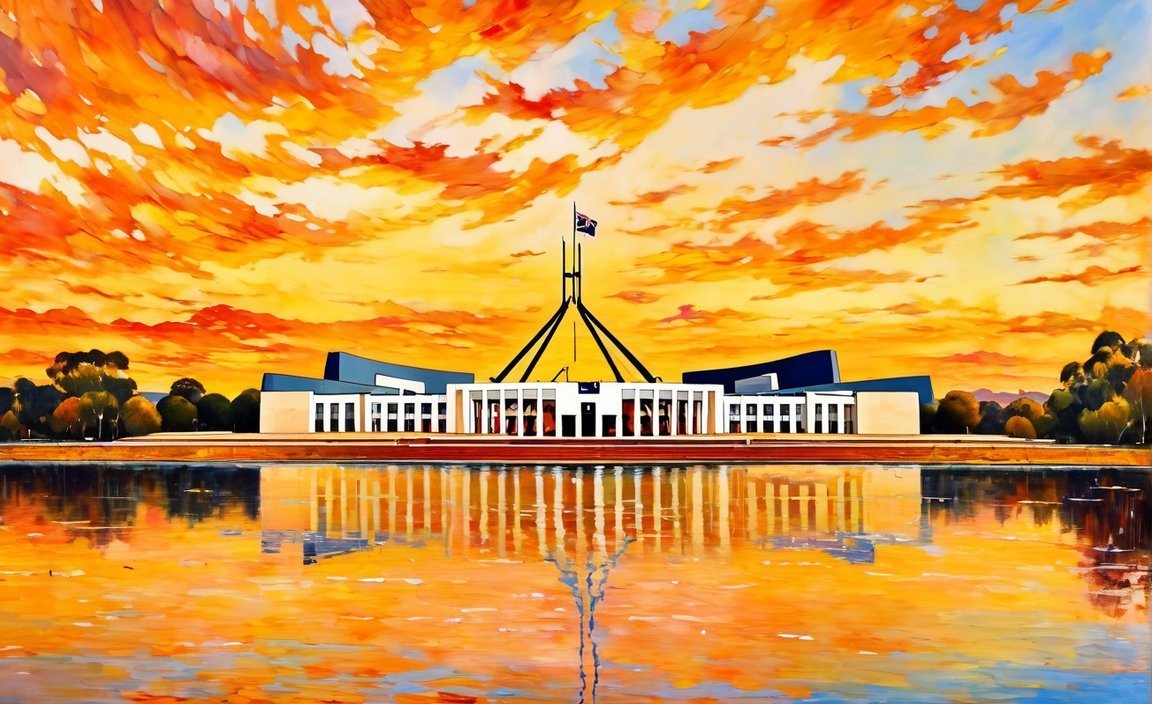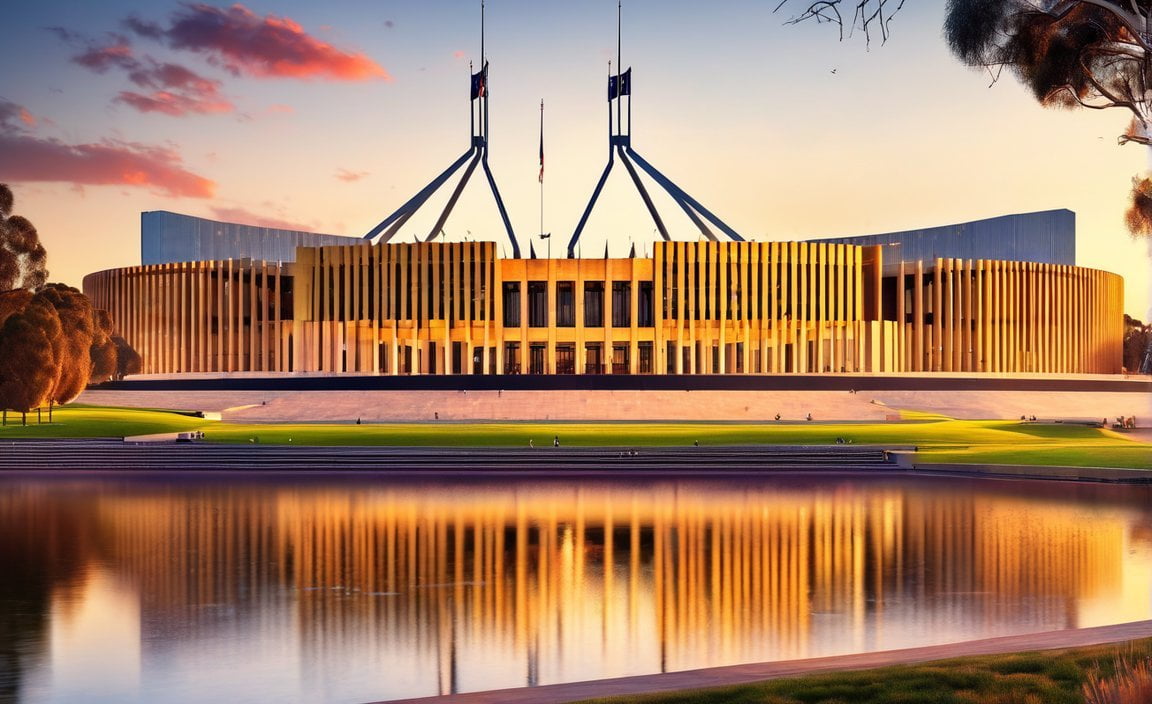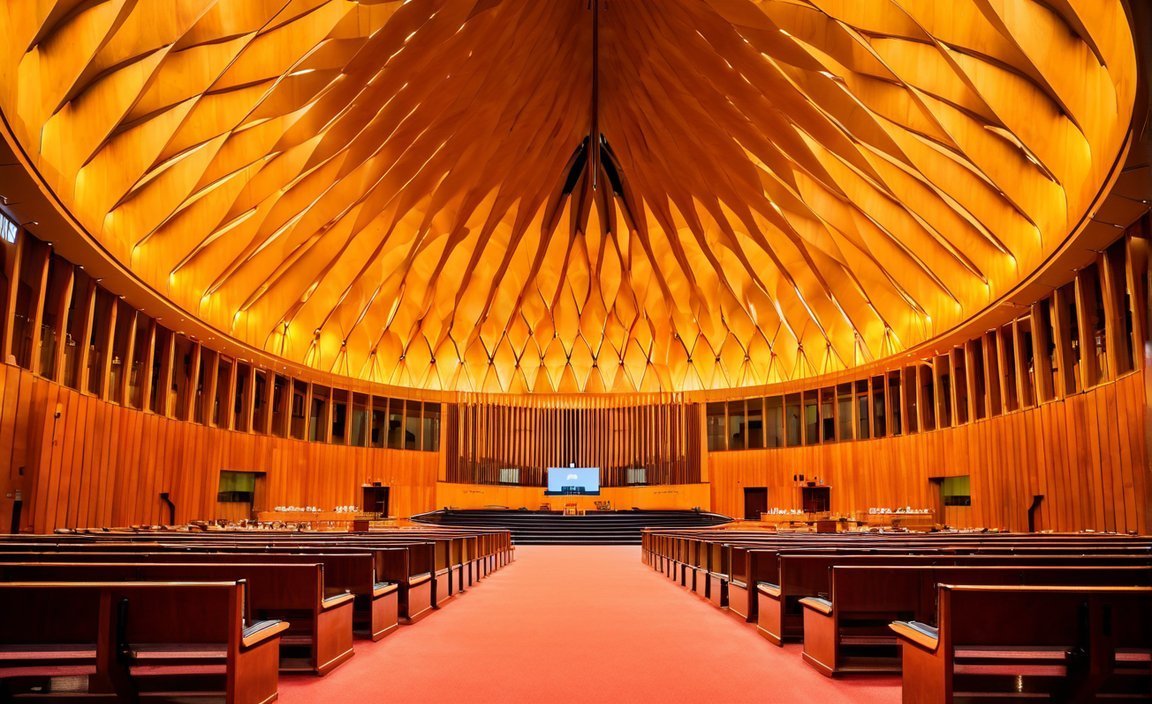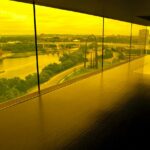Get ready for an inside look into the heart of Australian politics. In this article, we will uncover 10 fascinating facts about Parliament House Canberra, offering you a glimpse into the inner workings of this iconic institution. As a seasoned political journalist, I’m excited to share my insider knowledge and present you with a comprehensive understanding of the intriguing aspects that make Parliament House Canberra such a unique and captivating place. From the intricate parliamentary procedures to the captivating stories of key political figures, prepare to be amazed by the hidden treasures we are about to reveal.

Key Takeaways:
- Parliament House in Canberra receives around 1 million visitors yearly, including school groups.
- The iconic building was designed by Mitchell/Giurgola & Thorp Architects and constructed by a joint venture between Concrete Constructions and John Holland. It cost over A$1.1 billion to build.
- Queen Elizabeth II officially opened Parliament House on May 9, 1988.
- Prior to its establishment, federal parliamentary meetings were held in Melbourne until 1927.
- Parliament House is one of the largest buildings in the southern hemisphere, spanning 300 meters in length and width, with over 4,500 rooms and a floor area exceeding 250,000 square meters.
- When Parliament is in session, approximately 4,000 to 5,000 people work within the building.
- Canberra, the site of Parliament House, received its naming ceremony on March 12, 1913.
- One of the significant features of Parliament House is an 81-meter high, stainless steel flagpole that flies a massive Australian flag, weighing 15 kilograms.
- The flagpole is one of Australia’s tallest and serves as a prominent symbol of the building.
- Parliament House is equipped with state-of-the-art security measures to safeguard parliamentarians, staff, and visitors.
10 Interesting Facts About Parliament House Canberra
Parliament House Canberra is an iconic institution that plays a crucial role in Australian politics. From its grand architecture to its significant historical milestones, here are 10 fascinating facts about this renowned landmark.
Fact 1: A Popular Destination
Every year, Parliament House welcomes around 1 million visitors, including school groups eager to learn about the country’s democratic process and governance[^1]. It serves as a hub for civic education and engagement, allowing people to witness firsthand how the Australian government operates.
Fact 2: A Monumental Endeavor
Designed by Mitchell/Giurgola & Thorp Architects and constructed by a Concrete Constructions and John Holland joint venture, Parliament House Canberra is a monumental architectural achievement[^1]. With a price tag exceeding A$ 1.1 billion, it stands as a testament to the nation’s commitment to democracy and governance[^1].
Fact 3: Royal Inauguration
On 9 May 1988, Elizabeth II, the Queen of Australia, officially opened Parliament House in Canberra[^1]. The regal inauguration highlighted the significance of the building as the seat of government and symbolized the country’s democratic heritage.
Fact 4: A Historic Relocation
Prior to the establishment of Parliament House in Canberra, federal parliamentary meetings were held in Melbourne[^1]. The relocation to Canberra, the purpose-built capital city, marked a significant shift in the center of political power.
Fact 5: Monumental Dimensions
Parliament House Canberra stands as one of the largest buildings in the southern hemisphere[^2]. With dimensions of 300 meters in length and 300 meters in width, it boasts a massive floor area of over 250,000 square meters[^2]. The building encompasses an impressive 4,500 rooms, accommodating the diverse needs of parliamentarians and staff[^2].
Fact 6: A Bustling Workplace
When Parliament is in session, the building buzzes with activity, hosting approximately 4,000 to 5,000 people who work within its walls[^2]. From lawmakers and their staff to administrative personnel, the complex ecosystem of Parliament House reflects the intricate machinery of democratic governance.
Fact 7: A Momentous Naming Ceremony
Canberra, the capital city that houses Parliament House, was named during a special ceremony held on March 12, 1913[^2]. The event marked the birth of the purpose-built capital, which would later become the thriving epicenter of Australia’s democratic institutions.
Fact 8: Flying High
Parliament House boasts a grand feature in the form of an 81-meter high flagpole, which proudly flies an Australian flag measuring 12.8 by 6.4 meters and weighing 15 kilograms[^1]. Standing tall as one of the tallest flagpoles in Australia, it is an iconic symbol of national identity visible from a great distance.
Fact 9: Distinguished Security Measures
With security being of paramount importance, Parliament House is equipped with state-of-the-art security features[^3]. These measures serve to protect the parliamentarians, staff, and visitors within the building, ensuring the smooth functioning of democratic processes.
Fact 10: A Memorable Landmark
Parliament House Canberra stands as a memorable symbol of democracy, governance, and national pride. Its grandeur, historical significance, and the lively democratic activities it hosts make it an extraordinary institution that embodies Australia’s democratic spirit.
In conclusion, Parliament House Canberra serves as the vibrant heartbeat of Australian politics, welcoming visitors, nurturing democracy, and bearing witness to the nation’s democratic journey. Its rich history, impressive architecture, and pivotal role in governance contribute to its status as a national icon.
References:
[^1]: “Parliament House – Canberra – Ten Random Facts”. source
[^2]: “Parliament House, Canberra Facts for Kids”. source
[^3]: “Australia’s Parliament House – Parliamentary Education Office”. source
Here are 10 interesting facts about biomes that will blow your mind! Explore the wonders of different ecosystems by clicking here.
Learn about the fascinating process of condensation with these 10 interesting facts! Find out more by clicking here.
Discover the incredible world of marine biology through these 10 mind-boggling facts! Dive into the depths by clicking here.
Take a deep dive into the wonders of marine life with these 10 amazing facts! Immerse yourself in the ocean world by clicking here.
Explore the fascinating history and facts about the parliament house by clicking here.
Dive into the enchanting world of ponds with these 10 fascinating facts! Discover the secrets of these ecosystems by clicking here.
Embark on a journey to the savanna biome with these 10 captivating facts! Learn about the amazing features of this ecosystem by clicking here.
Uncover the mysteries of sea creatures with these 10 intriguing facts! Dive into the depths of the ocean by clicking here.
Discover the wonders of sea life through these 10 fascinating facts! Immerse yourself in the beauty of the ocean by clicking here.
Embark on an adventure to the taiga biome with these 10 mesmerizing facts! Explore the wonders of this unique ecosystem by clicking here.
Outline 3: Unique Features and Architectural Elements
Parliament House in Canberra is not just a seat of government; it is a masterpiece of architectural design with unique features that reflect the values and principles of Australia’s democracy. Let’s delve into 10 fascinating facts about the unique features and architectural elements of Parliament House in Canberra.
1. A Symbol of Democracy
Parliament House is not just a building, but a symbol of Australia’s democracy. Designed to showcase transparency, openness, and accessibility, its architecture represents the nation’s commitment to democratic principles.
2. Mitchell/Giurgola & Thorp Architects
The iconic design of Parliament House was the result of a collaboration between Mitchell/Giurgola & Thorp Architects. They aimed to create a structure that embodied the democratic ideals and fused them with the Australian landscape.
3. Boomerang-Shaped Wings
One of the most distinct features is the boomerang-shaped wings. These wings symbolize the coming together of the two houses of Parliament – the Senate and the House of Representatives. The wings stretch out from a central foyer, creating a visually striking and functional design.
4. An Impressive Flagpole
Standing tall at 81 meters, Parliament House boasts an impressive flagpole. This towering structure provides a powerful symbol of national identity as it flies an Australian flag measuring 12.8 by 6.4 meters.
5. Integration of Art and Craft
The design of Parliament House integrates commissioned art and craft works, reflecting Australia’s rich cultural heritage. From Indigenous artwork to sculptures and tapestries, these artistic contributions add depth and character to the building, creating a vibrant and inspiring environment.
6. Award-Winning Architecture
Both the old and new Parliament House have received the prestigious Engineering Heritage National Marker from Engineers Australia. This recognition highlights the significance of these buildings in Australia’s engineering history and acknowledges their architectural excellence.
7. Sustainable Design
Parliament House is committed to sustainable practices and embraces renewable energy solutions. In 2011, a pilot 43.3 kW photovoltaic system was installed on the roof, generating renewable energy for the building. The integration of sustainable design elements showcases Australia’s commitment to environmental stewardship.
8. Accessibility for Visitors
Parliament House is known for its openness and accessibility to visitors. Unlike many parliamentary buildings around the world, Parliament House welcomes tourists daily and offers guided tours that allow visitors to explore the historical and architectural significance of the building.
9. Function Events
Beyond its role as the seat of government, Parliament House serves as a central hub for various function events. From meetings and conferences to exhibitions and ceremonies, it provides a versatile space that accommodates the nation’s largest and most important gatherings.
10. Old Parliament House
Located nearby, the Old Parliament House offers a glimpse into Australia’s political history. Before the construction of the new Parliament House, it served as the home of the Australian Parliament. Today, it stands as a testament to the evolution of democracy in Australia.
Key Takeaways:
– Parliament House’s unique design and architectural features symbolize Australia’s democracy.
– The boomerang-shaped wings represent the Senate and the House of Representatives.
– The impressive flagpole stands at 81 meters and flies an Australian flag measuring 12.8 by 6.4 meters.
– The integration of art and craft adds cultural richness to the building.
– Parliament House has received recognition for its architectural excellence and contribution to Australia’s engineering heritage.
– It embraces sustainable design practices and incorporates renewable energy solutions.
– Parliament House is open and accessible to visitors, offering guided tours to explore its historical and architectural significance.
– It serves as a venue for various function events, including meetings, conferences, exhibitions, and ceremonies.
– The nearby Old Parliament House provides insights into Australia’s political history before the construction of the new Parliament House.
Sources:
– We Build Value
– Transport Network Australia
[Outline 4: Historical Significance and Evolution of Parliament House]
Parliament House in Canberra is not only a symbol of democracy and governance in Australia but also holds a rich historical significance. Let’s delve into the evolution of this iconic institution and explore some fascinating facts.
1. The Birth of a Purpose-Built Capital
Canberra, the purpose-built capital of Australia, was named during a special ceremony in 1913. This marked a historic moment as Melbourne and Sydney, the two largest cities in Australia, were rivals prior to the establishment of Canberra[^1^].
2. Shifting the Center of Political Power
Before Parliament House in Canberra, federal parliamentary meetings were held in Melbourne. The construction of a new Parliament House signified a significant shift in the center of political power, solidifying Canberra as the seat of government[^1^].
3. Architecture as a Fusion of Ideals
Designed by Mitchell/Giurgola & Thorp Architects, Parliament House aims to fuse democratic ideals with the Australian landscape. The boomerang-shaped wings represent the Senate and the House of Representatives, symbolizing the democratic foundation of the institution[^2^].
4. Recognition for Architectural Excellence
Both the old and new Parliament House have received recognition for their architectural excellence. The construction of Parliament House in Canberra, which cost over A$1.1 billion, was a significant architectural achievement[^1^].
5. Embracing Australia’s Cultural Heritage
Parliament House integrates commissioned art and craft works, reflecting Australia’s cultural heritage. These artworks contribute to the vibrant and diverse atmosphere of the institution, celebrating the nation’s identity and history[^2^].
6. Evolution of Function Events
Parliament House in Canberra serves as a venue for various function events. It has become a central location for hosting important events in Australia, welcoming guests from different walks of life and fostering engagement with the political sphere[^1^].
7. Solar Power Project
In 2011, a solar power project was commissioned on the roof of Parliament House. Taking sustainable practices into account, the Department of Parliamentary Services split the system between two stages, embracing the use of renewable energy[^1^].
8. State-of-the-Art Security Measures
As a symbol of democracy and governance, Parliament House prioritizes the safety of parliamentarians, staff, and visitors. The institution boasts state-of-the-art security measures, ensuring a secure environment within its iconic walls[^1^].
9. Connecting Past and Present
Parliament House in Canberra offers guided tours that allow visitors to explore its historical and architectural significance. The institution serves as a bridge between Australia’s political history and the current democratic landscape, fostering a deeper understanding of the nation’s governance[^1^].
10. Engineering Heritage National Marker
Both the old and new Parliament House have received an Engineering Heritage National Marker from Engineers Australia. This recognition highlights the engineering achievements in the construction and preservation of this iconic institution[^1^].
Key Takeaways:
- The construction of Parliament House in Canberra marked a historic shift in the center of political power.
- Architectural excellence and fusion of ideals are evident in the design of Parliament House, with its boomerang-shaped wings and integration of art and craft.
- The institution embraces sustainability with its solar power project and prioritizes security with state-of-the-art measures.
- Parliament House serves as a venue for important events and offers guided tours to connect visitors with Australia’s political history.
- The engineering achievements of both the old and new Parliament House have been recognized.
Sources:
[^1^]: Parliament House, Canberra Facts for Kids. Retrieved from source
[^2^]: Top 10 Amazing Facts about the Houses of Parliament. Retrieved from source
Outline 5: Notable Events and Controversies at Parliament House
Key Takeaways:
– Parliament House, Canberra has witnessed several notable events and controversies throughout its history.
– These events and controversies have had a significant impact on Australian politics and shaped public perception of the institution.
1. The Dismissal of Prime Minister Gough Whitlam
One of the most controversial events in Australian political history took place at Parliament House in 1975. The then Governor-General, Sir John Kerr, dismissed Prime Minister Gough Whitlam, causing a constitutional crisis. This event not only sparked intense public debate but also led to the resignation of Kerr and the subsequent election of a new government.
Citation: Wikipedia – Dismissal of Gough Whitlam
2. The Mabo Decision and Native Title
In 1992, the High Court of Australia delivered the landmark Mabo decision, recognizing the existence of native title for the Indigenous people. This decision had a profound impact on Australian society and marked a significant step towards reconciliation. The Parliament House played a crucial role in shaping and passing legislation to give effect to the Mabo decision.
Citation: Wikipedia – Mabo v Queensland (No 2)
3. Same-Sex Marriage Legalization
In a historic moment, Parliament House became the venue for the passage of the Marriage Amendment (Definition and Religious Freedoms) Act 2017. This legislation legalized same-sex marriage in Australia and demonstrated the evolving social attitudes towards equality and diversity. The passing of this act was celebrated as a significant step towards inclusivity and human rights.
Citation: Wikipedia – Same-sex marriage in Australia
4. Leadership Challenges and Political Turmoil
Parliament House has witnessed several leadership challenges and periods of political turmoil. These events often involve party factions, power struggles, and intense media scrutiny. They reflect the dynamics of Australian politics and the influence of public opinion on political decision-making.
Citation: Australia’s Political Leadership Challenges
5. The “Sports Rorts” Scandal
The “Sports Rorts” scandal, which emerged in 2020, shed light on questionable allocation of government funds for sports grants. This controversy raised concerns about political favoritism and misuse of taxpayer money. The investigation and public discussions surrounding this scandal highlighted the importance of transparency and accountability in the governance of public funds.
Citation: ABC News – Sports Rorts
As Parliament House, Canberra continues to be the epicenter of Australian politics, it remains essential for journalists and the public to stay informed about the notable events and controversies that shape the nation’s democracy. While these events may stir debate and challenge the political landscape, they also serve as reminders of the importance of an accountable and transparent parliamentary system.
Key Takeaways:
- The dismissal of Prime Minister Gough Whitlam in 1975 caused a constitutional crisis and sparked intense public debate.
- The Mabo decision in 1992 recognized native title for Indigenous people, leading to significant legislative reforms.
- Parliament House played a pivotal role in the passage of the Marriage Amendment Act 2017, legalizing same-sex marriage.
- Leadership challenges and political turmoil have been recurrent in Parliament House, reflecting Australian politics’ dynamic nature.
- The “Sports Rorts” scandal highlighted concerns about political favoritism and the allocation of government funds, emphasizing the need for transparency and accountability.
Citations:
– Wikipedia – Dismissal of Gough Whitlam
– Wikipedia – Mabo v Queensland (No 2)

FAQ
Q1: How many visitors does Parliament House in Canberra cater to every year?
A1: Parliament House in Canberra caters to approximately 1 million visitors every year, including school groups. [^1]
Q2: Who designed and built Parliament House in Canberra?
A2: Parliament House in Canberra was designed by Mitchell/Giurgola & Thorp Architects and built by a joint venture between Concrete Constructions and John Holland. The construction cost exceeded A$ 1.1 billion. [^1]
Q3: When was Parliament House in Canberra opened?
A3: Parliament House in Canberra was opened on May 9, 1988, by Elizabeth II, Queen of Australia. [^1]
Q4: Where were Federal Parliament meetings held before Parliament House in Canberra?
A4: Federal Parliament meetings were held in Melbourne until 1927, before the establishment of Parliament House in Canberra. [^1]
Q5: What are some key features of Parliament House in Canberra?
A5: Parliament House in Canberra is one of the largest buildings in the southern hemisphere, measuring 300 meters long and wide, with a floor area of over 250,000 square meters and more than 4,500 rooms. It also boasts an 81-meter high flagpole flying a 12.8 by 6.4-meter Australian flag, making it one of the tallest flagpoles in Australia. Additionally, the building is equipped with state-of-the-art security features to ensure the safety of parliamentarians, staff, and visitors. [^1] [^2] [^3]
















